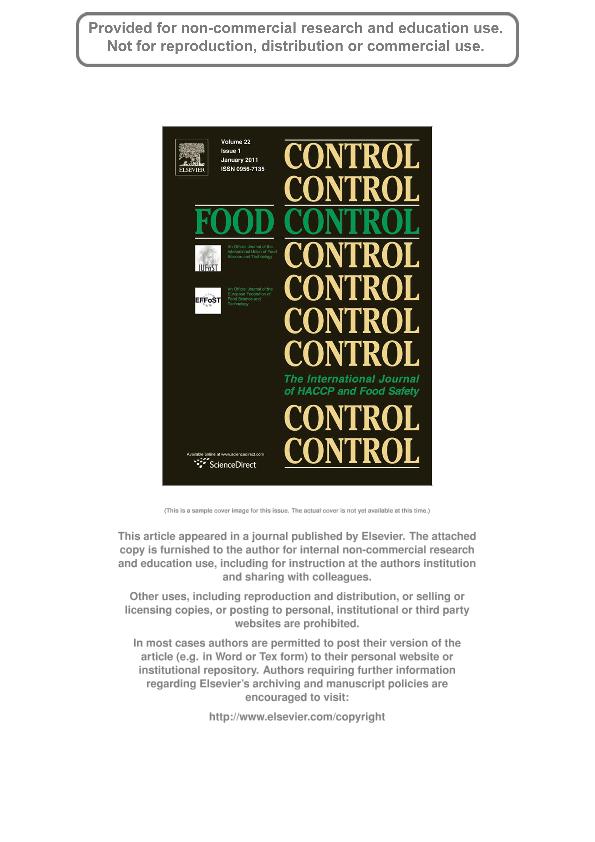Mostrar el registro sencillo del ítem
dc.contributor.author
Pavón, Miguel Ángel
dc.contributor.author
Luna, Agustin

dc.contributor.author
de la Cruz, Silvia

dc.contributor.author
González, Isabel
dc.contributor.author
Martín, Rosario
dc.contributor.author
García, Teresa
dc.date.available
2018-04-18T15:15:42Z
dc.date.issued
2012-05
dc.identifier.citation
Pavón, Miguel Ángel; Luna, Agustin; de la Cruz, Silvia; González, Isabel; Martín, Rosario; et al.; PCR-based assay for the detection of Alternaria species and correlation with HPLC determination of altenuene, alternariol and alternariol monomethyl ether production in tomato products; Elsevier; Food Control; 25; 1; 5-2012; 45-52
dc.identifier.issn
0956-7135
dc.identifier.uri
http://hdl.handle.net/11336/42452
dc.description.abstract
Alternaria spp. contamination and subsequent production of mycotoxins is a common problem in vegetable crops. Identification of Alternaria species by traditional methods requires specific skills and may not detect toxigenic moulds inactivated by food processing. By using molecular methods such as PCR the detection of Alternaria spp. becomes possible directly from the food or feed samples. In this study, a PCR method based on the Internal Transcribed Spacer (ITS) genetic marker has been used for detection of Alternaria spp. in raw and processed commercial tomato samples. Occurrence of altenuene, alternariol and alternariol methyl ether in the samples was analysed by high-performance liquid chromatography (HPLC) in order to assess the ability of the PCR assay to identify tomato samples containing Alternaria mycotoxins. The PCR assay revealed the presence of Alternaria spp. DNA in 41 out of 90 commercial samples (45.6%), while HPLC detected at least one of the Alternaria mycotoxins within 31 of the PCR positive samples. Detection of Alternaria DNA correlated well with the presence of the analysed Alternaria mycotoxins, indicating that the PCR protocol developed in this work for detection of Alternaria spp. DNA could be used as an indirect marker of the presence of Alternaria mycotoxins in raw and processed tomato products.
dc.format
application/pdf
dc.language.iso
eng
dc.publisher
Elsevier

dc.rights
info:eu-repo/semantics/openAccess
dc.rights.uri
https://creativecommons.org/licenses/by-nc-sa/2.5/ar/
dc.subject
Alternaria Spp.
dc.subject
Pcr
dc.subject
Mycotoxin
dc.subject
Hplc
dc.subject
Tomato Products
dc.subject.classification
Otras Ciencias Biológicas

dc.subject.classification
Ciencias Biológicas

dc.subject.classification
CIENCIAS NATURALES Y EXACTAS

dc.title
PCR-based assay for the detection of Alternaria species and correlation with HPLC determination of altenuene, alternariol and alternariol monomethyl ether production in tomato products
dc.type
info:eu-repo/semantics/article
dc.type
info:ar-repo/semantics/artículo
dc.type
info:eu-repo/semantics/publishedVersion
dc.date.updated
2018-04-10T14:06:18Z
dc.journal.volume
25
dc.journal.number
1
dc.journal.pagination
45-52
dc.journal.pais
Países Bajos

dc.journal.ciudad
Amsterdam
dc.description.fil
Fil: Pavón, Miguel Ángel. Universidad Complutense de Madrid. Facultad de Veterinaria; España
dc.description.fil
Fil: Luna, Agustin. Consejo Nacional de Investigaciones Científicas y Técnicas. Centro Científico Tecnológico Conicet - Córdoba. Instituto de Investigaciones Biológicas y Tecnológicas. Universidad Nacional de Córdoba. Facultad de Ciencias Exactas, Físicas y Naturales. Instituto de Investigaciones Biológicas y Tecnológicas; Argentina
dc.description.fil
Fil: de la Cruz, Silvia. Universidad Complutense de Madrid. Facultad de Veterinaria; España
dc.description.fil
Fil: González, Isabel. Universidad Complutense de Madrid. Facultad de Veterinaria; España
dc.description.fil
Fil: Martín, Rosario. Universidad Complutense de Madrid. Facultad de Veterinaria; España
dc.description.fil
Fil: García, Teresa. Universidad Complutense de Madrid. Facultad de Veterinaria; España
dc.journal.title
Food Control

dc.relation.alternativeid
info:eu-repo/semantics/altIdentifier/url/https://www.sciencedirect.com/science/article/pii/S0956713511004130
dc.relation.alternativeid
info:eu-repo/semantics/altIdentifier/doi/http://dx.doi.org/10.1016/j.foodcont.2011.10.009
Archivos asociados
